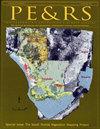基于Sentinel-1A图像的持续散射体干涉法在印度Pettimudi滑坡监测中的应用
IF 2
4区 地球科学
Q4 GEOGRAPHY, PHYSICAL
引用次数: 3
摘要
持续监测地表运动对评估滑坡触发因素和减轻滑坡危害至关重要。本研究的重点是测量由强降雨引起的拉贾马拉山西坡破坏性滑坡事件造成的水平和垂直地表位移。2020年8月6日至7日,印度喀拉拉邦伊杜基地区的茶园村佩蒂木迪发生山体滑坡。采用持续散射体合成孔径雷达干涉测量技术(PSInSAR)和斯坦福持续散射体方法(StaMPS)研究了地表随时间的运动。采用下降通道获取的20幅Sentinel-1A单目复杂图像(19幅干涉图)叠加进行PSInSAR处理。在每个测点位置测量了长时间序列的视距位移,从而测量了平均视距速度。将平均LOS速度分解为水平东西速度分量和垂直上下速度分量。结果表明:研究区平均LOS、EW和上下速度分别为-18.76 ~ +11.88、-10.95 ~ +6.93和-15.05 ~ +9.53 mm/y, LOS位移范围为-19.60 ~ +19.59 mm。位移值清楚地表明地形的不稳定性。应用PSInSAR技术得到的时序LOS位移趋势非常有用,可以为灾害管理和灾害预警系统的发展提供宝贵的投入,造福当地居民。本文章由计算机程序翻译,如有差异,请以英文原文为准。
Persistent Scatterer Interferometry for Pettimudi (India) Landslide Monitoring using Sentinel-1A Images
The continuous monitoring of land surface movement over time is of paramount importance for assessing landslide triggering factors and mitigating landslide hazards. This research focuses on measuring horizontal and vertical surface displacement due to a devastating landslide event in
the west-facing slope of the Rajamala Hills, induced by intense rainfall. The landslide occurred in Pettimudi, a tea-plantation village of the Idukki district in Kerala, India, on August 6–7, 2020. The persistent-scatterer synthetic aperture radar interferometry (PSInSAR ) technique,
along with the Stanford Method for Persistent Scatterers (StaMPS), was applied to investigate the land surface movement over time. A stack of 20 Sentinel-1A single-look complex images (19 interferograms) acquired in descending passes was used for PSInSAR processing. The line-of-sight (LOS
) displacement in long time series, and hence the average LOS velocity, was measured at each measurement-point location. The mean LOS velocity was decomposed into horizontal east–west (EW ) and vertical up–down velocity components. The results show that the mean LOS, EW, and up–down
velocities in the study area, respectively, range from –18.76 to +11.88, –10.95 to +6.93, and –15.05 to +9.53 mm/y, and the LOS displacement ranges from –19.60 to +19.59 mm. The displacement values clearly indicate the instability of the terrain. The time-series LOS
displacement trends derived from the applied PSInSAR technique are very useful for providing valuable inputs for disaster management and the development of disaster early-warning systems for the benefit of local residents.
求助全文
通过发布文献求助,成功后即可免费获取论文全文。
去求助
来源期刊

Photogrammetric Engineering and Remote Sensing
地学-成像科学与照相技术
CiteScore
1.70
自引率
15.40%
发文量
89
审稿时长
9 months
期刊介绍:
Photogrammetric Engineering & Remote Sensing commonly referred to as PE&RS, is the official journal of imaging and geospatial information science and technology. Included in the journal on a regular basis are highlight articles such as the popular columns “Grids & Datums” and “Mapping Matters” and peer reviewed technical papers.
We publish thousands of documents, reports, codes, and informational articles in and about the industries relating to Geospatial Sciences, Remote Sensing, Photogrammetry and other imaging sciences.
 求助内容:
求助内容: 应助结果提醒方式:
应助结果提醒方式:


